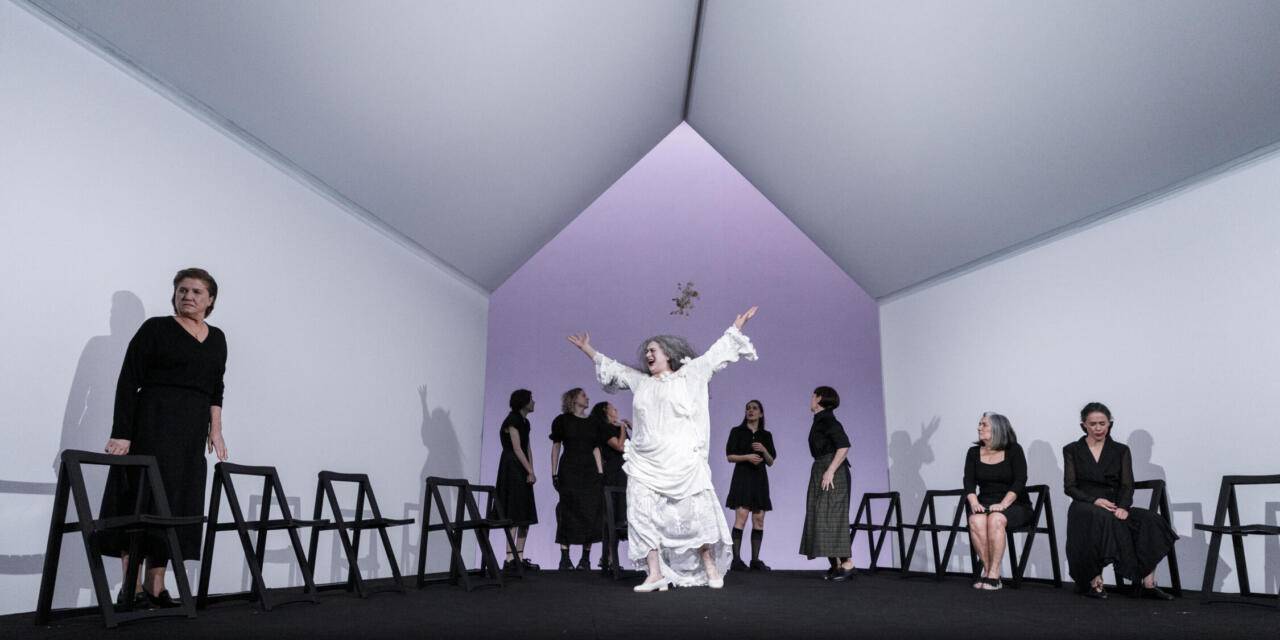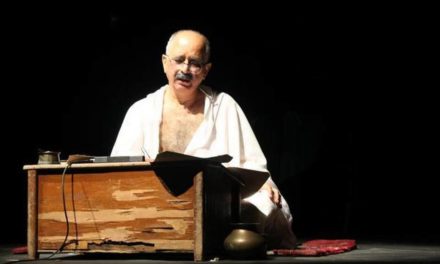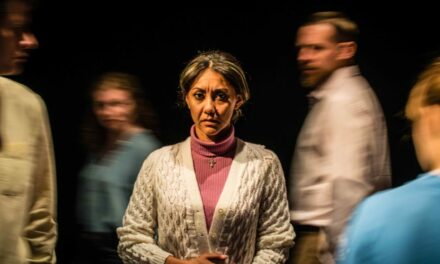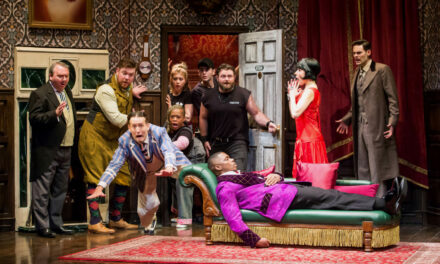The 2023/2024 season has proved the year of Bernarda Albas. Lorca’s 1936 drama was completed only a few months before his death, as Spain was edging closer to civic conflict. Its razor-sharp observations of a family falling apart as resentment, frustration and containment take hold has never felt more pertinent or timely. November 2023 saw Rebecca Frecknall deploy a new version of the text by Alice Birch in a National Theatre production that presented a glass house where each of the sisters was always on display, always under observation from a watchful matriarch and the culture of surveillance she had put into operation. Harriet Walter excelled as Bernarda – at once upholding the operation of vigilance while watching it crumble around her.
At Madrid’s Centro Dramático Nacional, Alfredo Sanzol provides a brisk reading where Bernarda’s journey feels interiorised to a degree perhaps not evidenced in previous interpretations of Lorca’s title protagonist. Ana Wagener’s Bernarda is less the fireworks and fire of Harriet Walter, or Glenda Jackson in Nuria Espert’s legendary 1986 production, and more a weary materfamilias who opens the play worn down by the struggles of keeping up appearances. She can’t wait to remove the formal jacket worn for the funeral and send away the mourners that she accuses of watching her with mean intentions. The battle lines appear drawn from the very start. The daughters are positioned in the opening scene stage right while the outside mourners face them stage left. Bernarda stands firm and still as others move around her – most conspicuously in Act 1, Inma Nieto’s flustering servant. There are flashes of anger as Bernarda loses her temper, but it is as if she is then frustrated with herself for letting her façade down in the brief moments where things just get too much.
The tone merges a naturalistic performance register with moments of danztheater. Sanzol opens the production with Claudia Galán’s Adela caressing the green dress she will then put on in Act 1. The dance she performs sets the scene for a tale of desire and loss, ostensibly positioning Adela as the piece’s protagonist. Sara Robisco’s Martirio also wilts and falls to the floor in Act 1 – but she rises again and sits in silence. Patricia López Arnaíz’s Angustias reaches up to the heavens in Act 3 – as if trying to catch a Pepe which might remain just forever out of reach. In each case this physicalised gesture is an embodiment of a frame of mind, an instance where the audience is given a glimpse into the character’s state of mind.
Blanca Añón’s scenography is fittingly bleak and conceptual – an empty room with white walls and stark lighting where everything is brutally on display. The design lines are rigid and symmetrical pointing to order and severity. Pedro Yagüe’s lighting is fittingly atmospheric – from lilac hues on the day of Antonio María Benavides’ funeral to the eerie green hues of Act 3. The set has more in common with an irreal virtual landscape than the white-washed houses of Andalusia. Indeed, Sanzol’s reading, like that of Calixto Bieito in 1998, avoids local or rural referents: there are no stone walls, no mantillas, or other Andalusian iconography. This is less a drama about women in the villages of Spain and more a study of domestic disintegration.
The walls are removed in Act 3, providing a porous space where the outside world can more easily seep in, with disastrous consequences. At the production’s opening, a cobweb-like black and white curtain allows the shape of the room within to be made out. It encourages the audience to look beyond the surface, beyond the filter placed before our eyes to see what lies beneath. Each act opens with the lace curtain in place — a permeable fabric which both exposes and masks, echoing Lorca’s coded writing.
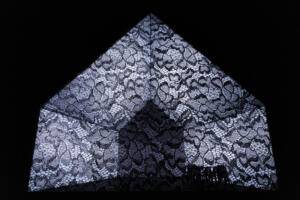
The cobweb-like filter that opens each act of Sanzol’s The House of Bernarda Alba. Photo: Bárbara Sánchez Palomero.
A table and chairs stage left are moved into place for the theatre of mourning that the Alba family stage for their neighbours in the play’s opening act. The tension between the tolling bells that can be heard as the audience make their way into the auditorium and the pulsating pop music that overrides it as Adela dances with the green dress points to two worlds in collision. The shape of the room suggests a church — a hallowed space of stark austerity — but one which feels conceptual rather than real. Ane Gabarain’s Poncia munches her way through the opening scene. Her hearty laughter and smoker’s cough contrasts with the antiseptic tones of Wagener’s Bernarda. Gabarain’s Poncia is jovial and pragmatic, her hoarse voice cutting through the reverent silence. In many ways her laughter creates a parallel with Ester Bellver’s María Josefa with her long wiry grey hair and bouncy energy. The latter rushes on stage refusing to be captured, flashing genitals while giggling at her horrified granddaughters. As the rest of the family try and keep her controlled, she provides an image of unbridled sexual energy that no one else, not even Adela, can match. Only Poncia keeps her distance, refusing to hold her down.
Sanzol finds a performance register that merges the historical with the modern. The daughters’ black dresses have a modern cut; Sara Robisco’s Martirio in particular boasting a gothic feel to her knee length outfit. Galán’s Adela has knee high socks that flash a discreet amount of exposed flesh between hem and knee. Belén Landaluce’s Magdalena has an exposed back, only visible if she chooses to turn her back to the audience. These sisters all have secrets. Patricia López Arnaiz’s Angustias ensures her dress rubs close to her ankles. With her hair tied back – a contrast to the wilder hair of her sisters — her poise and demeanour points to a modesty that is increasingly challenged by her feisty responses to her mother and sisters. Sanzol is not afraid of showing moments of warmth between the sisters – Magdalena, Amelia and Adela laugh on the floor in Act 1 and there is dance and laughter as Adela dances in her green dress. The complicity between Eva Carrera’s Amelia and Robisco’s Martirio is played out in Act 2 as they sit sewing trousseaus together. Martirio’s isolation from her sisters, however, is also ever more present as the action progresses: she is sitting alone when the discovery is made that she has stolen Pepe el Romano’s photograph from Angustias’ bedroom.
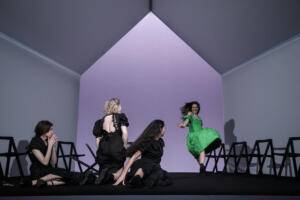
Adela (Claudia Galán) dances in a green dress while her sisters Martirio (Sara Robisco), Magdalena (Belén Landaluce) and Amelia (Eva Carrera) look on. Photo: Bárbara Sánchez Palomero.
Ana Wagener displays flashes of anger – almost hitting Magdalena in frustration, her eyes betraying vexation that she attempts to control with a voice that only rarely rises in infuriation. She clenches her fists in frustration at the revelation of Martirio’s theft of her sister’s photograph and there is some aggressive pushing as Poncia reacts to Bernarda’s harsh words about her mother’s reputation. The sister’s recoil in horror as Bernarda announces eight years of mourning as if were the most acceptable thing in the world. At the end of the play, as Poncia confronts Bernarda, Wagener’s Bernarda places her hands on her temples as if trying to shut the reality out while insisting in a quiet, hissing voice on silence. Sanzol often positions Bernarda alone; others are fearful of getting too close. It points to her isolation from her first appearance and shows her as a weak figure that does not know the importance of building bridges. In the final scene, she appears in black pyjamas — a veritable visible contrast to her daughters and Poncia all in white nightwear.
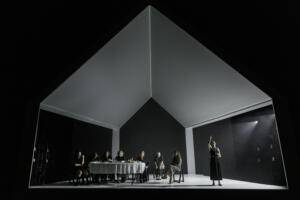
Angustias (Patricia López Arnaiz) reaches for the skies as the family dines with Prudencia at the opening of Act 3. Photo: Bárbara Sánchez Palomero.
Act 3 has the neighbour Prudencia sitting apart from the family as they have dinner together. Poncia too sits behind the family – both characters positioned as outsiders as Bernarda and her daughters cluster around the table with its white crochet tablecloth. The sisters’ coming and goings through the night are managed with a telling attention to the culture of surveillance that all the sisters’ police. The build-up to Adela’s suicide involves some expertly choreographed action with characters trying to evade each other’s watchful glances. The staging does not have the languid pacing of other readings, rather opting for a rhythm where the sisters busy themselves — there is little silence here — with activities that don’t always have a clear purpose. This is a family devoid of a raison d’être, one of the production’s distinctive qualities.
Sanzol’s production of The House of Bernarda Alba has less fireworks than Lluís Pasqual’s 2009 staging where Nuria Espert was a fierce matriarch in a compelling battle with Rosa Maria Sardà’s feisty, funny Poncia. Sanzol encourages a greater degree of audience detachment in the contained pod-like structure in which the family operates. This is a production that simmers rather than boils, but it shows all too clearly how dysfunctional the family’s operational model is and how the financial transactions that Bernarda makes to protect the family’s diminishing wealth and supposed reputation are nowhere near as effective as she would like to think. The final image may have her seeking to impose silence on a house in turmoil, but the tide may, as the sisters’ unease demonstrates, already have turned.
La casa de Bernarda Alba, a production by the Centro Dramático Nacional directed by Alfredo Sanzol, plays at Madrid’s Teatro María Guerrero Madrid from 9 February to 31 March 2024. It then tours to the Teatro Calderón, Valladolid (5-7 April), the Gran Teatro Córdoba (12-13 April), the Teatro Romea Murcia (19-20 April), the Teatro Gayarre Pamplona (26-27 April), and the Teatro Principal Palma de Mallorca (3-4 May).
This post was written by the author in their personal capacity.The opinions expressed in this article are the author’s own and do not reflect the view of The Theatre Times, their staff or collaborators.
This post was written by Maria Delgado.
The views expressed here belong to the author and do not necessarily reflect our views and opinions.

